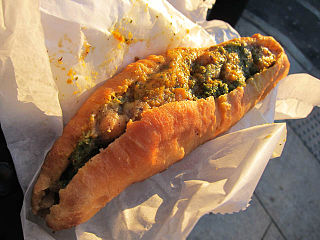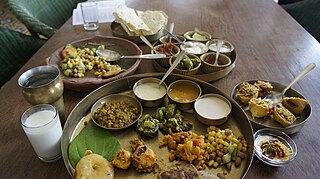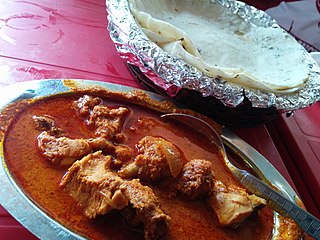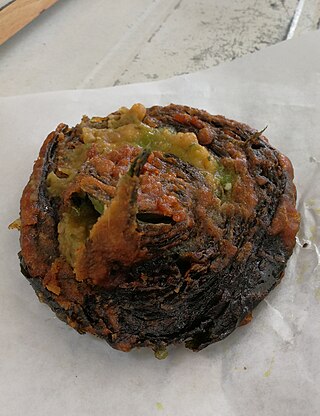
This article is about the demography of the population of Trinidad and Tobago including population density, ethnicity, education level, health of the populace, economic status, religious affiliations and other aspects of the population.

Roti is a round flatbread native to the Indian subcontinent. It is commonly consumed in many South Asian, Southeast Asian, Caribbean, and Southeast African countries.

Trinidad and Tobago has a unique history and its food is influenced by Indian-South Asian, West African, Creole, European, American, Chinese, Amerindian, and Latin American culinary styles. Trinidadian and Tobagonian food is dominated by a wide selection of dishes, most notably, doubles, roti, pelau, callaloo and curried crab and dumplings. Trinidad and Tobago is also known for its prepared provisions, such as dasheen, sweet potato, eddoes, cassava, yam, soups and stews, also known as blue food across the country. Corresponding to the Blue Food Day event held annually in Trinidad and Tobago.
The culture of Trinidad and Tobago reflects the influence of Indian-South Asian, African, Indigenous, European, Chinese, North American, Latino, and Arab cultures. The histories of Trinidad and Tobago are different. There are differences in the cultural influences which have shaped each island. Trinidad and Tobago is an English-speaking country with strong links to the United Kingdom.

Hinduism in Trinidad and Tobago is the second largest religion. Hindu culture arrived to Trinidad and Tobago in 1845, with the arrival of the first Indian indentured laborers, the overwhelming majority of which were Hindu. According to the 2011 census there were 240,100 declared Hindus in Trinidad and Tobago.

An aloo pie is a Caribbean fast food dish originating from and common in Trinidad and Tobago.
Indo-Guyanese or Indian-Guyanese, are Guyanese nationals of Indian origin who trace their ancestry to India and the wider subcontinent. They are the descendants of indentured servants and settlers who migrated from India beginning in 1838, and continuing during the British Raj.

Doubles is a common street food originating in Trinidad and Tobago with Indian origin. It is normally eaten during breakfast, but is also eaten occasionally during lunch or as a late night snack and popular hangover food for local Trinidadians. Doubles is made with two baras and filled with curry channa and various chutneys.
Indo-Caribbean Americans or Indian-Caribbean Americans, are Americans who trace their ancestry ultimately to India, though whose recent ancestors lived in the Caribbean, where they migrated beginning in 1838 as indentured laborers. There are large populations of Indo-Trinidadian and Tobagonians and Indo-Guyanese along with a smaller population of Indo-Surinamese, Indo-Jamaicans and other Indo-Caribbeans in the United States, especially in the New York metropolitan area and Florida. The Washington metropolitan area, Texas, and Minnesota also have small numbers of Indo-Guyanese and Indo-Trinidadians. Indo-Caribbean Americans are a subgroup of Caribbean Americans as well as Indian Americans, which are a subgroup of South Asian Americans, which itself is a subgroup of Asian Americans.

Gujarati cuisine is the cuisine of the Indian state of Gujarat. The typical Gujarati thali consists of rotli, dal or curry, rice, and shaak. The thali will also include preparations made from pulses or whole beans such as moong, black eyed beans etc., a snack item (farsaan) like dhokla, pathra, samosa, fafda, etc. and a sweet (mishthaan) like mohanthal, jalebi, sevaiya etc.

Trinidad and Tobago, officially the Republic of Trinidad and Tobago, is the southernmost island country in the Caribbean. Consisting of the main islands Trinidad and Tobago and numerous much smaller islands, it is situated 11 kilometres off the coast of northeastern Venezuela and 130 kilometres south of Grenada. It shares maritime boundaries with Barbados to the east, Grenada to the northwest and Venezuela to the south and west. Trinidad and Tobago is generally considered to be part of the West Indies. The island country's capital is Port of Spain, while its largest and most populous municipality is Chaguanas.

Caribbean Hindustani is an Indo-Aryan language spoken by Indo-Caribbeans and the Indo-Caribbean diaspora. It is a koiné language mainly based on the Bhojpuri and Awadhi dialects. These Hindustani dialects were the most spoken dialects by the Indians who came as immigrants to the Caribbean from Colonial India as indentured laborers. It is closely related to Fiji Hindi and the Bhojpuri-Hindustani spoken in Mauritius and South Africa.
Bhojpuri cuisine is a style of food preparation common among the Bhojpuri people of Bihar and eastern Uttar Pradesh in India, and also the Terai region of Nepal. Bhojpuri foods are mostly mild and tend to be less hot in terms of spices used. The cuisine consists of both vegetable and meat dishes.

Chicken curry or curry/curriedchicken is a South Asian dish originating from India. It is common in the Indian subcontinent, Caribbean, Arabian Peninsula, Southeast Asia, Great Britain, and Japan. A typical curry from the Indian subcontinent consists of chicken stewed in an onion- and tomato-based sauce, flavoured with ginger, garlic, tomato puree, chilli peppers and a variety of spices, often including turmeric, cumin, coriander, cinnamon, and cardamom. Outside of South Asia, chicken curry is often made with a pre-made spice mixture known as curry powder.
Indo-Belizeans, also known as East Indian Belizeans, are citizens of Belize of Indian ancestry. The community made up 3.9% of the population of Belize in 2010. They are part of the wider Indo-Caribbean community, which itself is a part of the global Indian diaspora.
Awadhi cuisine is a cuisine native to the Awadh region in Northern India and Southern Nepal. The cooking patterns of Lucknow are similar to those of Central Asia, the Middle East, and Northern India and western India with the cuisine comprising both vegetarian and non-vegetarian dishes. The Awadh region has been influenced by Mughal cooking techniques, and the cuisine of Lucknow bears similarities to those of Central Asia, Kashmir, Punjab and Hyderabad. The city is also known for its Nawabi foods.
The Punjabi diaspora refers to the descendants of ethnic Punjabis who emigrated out of the Punjab region in the northern part of the South Asia to the rest of the world. Punjabis are one of the largest ethnic groups in both the Pakistani and Indian diasporas. The Punjabi diaspora numbers around the world has been given between 2.5 and 10 million, mainly concentrated in Britain, Canada, United States, Western Europe, Southeast Asia, the Middle East, Australia and New Zealand.

Pholourie, also spelled phulourie or phoulourie, is a snack food of Indo-Caribbean origin that is commonly eaten in Trinidad and Tobago, Guyana, Suriname and other parts of the Caribbean. It consists of fried, spiced split pea and flour dough balls that are served with a chutney.

Vada, vadai, wada, or bara is a category of savoury fried snacks native to India. Vadas can be described variously as fritters, cutlets, or dumplings. Vadas are sometimes stuffed with vegetables and traditionally served with chutneys and sambar.

Saheena are a street-food and snack of Indian origin in Trinidadian cuisine.





















